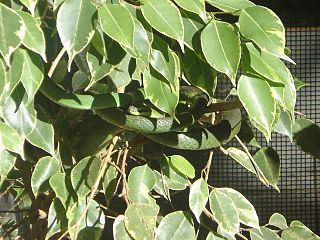
The smooth green snake is a species of North American nonvenomous snake in the family Colubridae. The species is also referred to as the grass snake. It is a slender, "small medium" snake that measures 36–51 cm (14–20 in) as an adult. It gets its common name from its smooth dorsal scales, as opposed to the rough green snake, which has keeled dorsal scales. The smooth green snake is found in marshes, meadows, open woods, and along stream edges, and is native to regions of Canada, the United States, and northern Mexico. A non-aggressive snake, it seldom bites and usually flees when threatened. It mates in late spring to summer, and females lay their eggs from June to September. The smooth green snake will often bob its head in order to mimic vegetation blowing in the wind.

Oxyrhopus petolarius, commonly known as the forest flame snake, is a species of mildly venomous snake in the family Colubridae. The species is endemic to Central and South America. There are three recognized subspecies.

Chironius is a genus of New World colubrid snakes, commonly called sipos, savanes, or sometimes vine snakes. There are 23 described species in this genus.
Doria's green snake is a species of snake in the family Colubridae. The species is endemic to Asia.

Ptyas mucosa, commonly known as the Oriental rat snake, dhaman or Indian rat snake, is a common non-venomous species of colubrid snake found in parts of South and Southeast Asia. Dhamans are large snakes. Typical mature total length is around 1.5 to 1.95 m though some exceed 2 m. The record length for this species was 3.7 m, second only to their cousin Ptyas carinata among living colubrid snakes. Despite their large size, oriental ratsnakes are usually quite slender with even a specimen of 2 m commonly measuring 4 to 6 cm only around in diameter. Furthermore, the average weight of ratsnakes caught in Java was around 877 to 940 g, though larger males of over 2.3 m may easily weigh over 2.5 kg (5.5 lb). Their color varies from pale browns in dry regions to nearly black in moist forest areas. Rat snakes are diurnal, semi-arboreal, non-venomous, and fast-moving. Rat snakes eat a variety of prey and are frequently found in urban areas where rodents thrive.

Tropidoclonion is a genus of snake in the subfamily Natricinae of the family Colubridae. The genus is monotypic, containing the sole species Tropidoclonion lineatum, commonly known as the lined snake. The species is endemic to North America.

Opheodrys aestivus, commonly known as the rough green snake, is a nonvenomous North American colubrid. It is sometimes called grass snake or green grass snake, but these names are more commonly applied to the smooth green snake. The European colubrid called grass snake is not closely related. The rough green snake is docile, often allowing close approach by humans, and seldom bites. Even when bites occur, they have no venom and are harmless.

Dasypeltis scabra, known as the common egg eater, egg-eating snake or rhombic egg eater, is a species of snake in the family Colubridae. It is endemic to Africa.

The smooth earth snake is a species of nonvenomous natricine colubrid snake native to the eastern half of the United States.
Frank Nelson Blanchard was an American herpetologist, and professor of zoology at the University of Michigan from which institution he received his Ph.D. He is credited with describing several new subspecies, including the broad-banded water snake, Nerodia fasciata confluens, and the Florida king snake, Lampropeltis getula floridana. As well, he has been honored by having reptiles and amphibians named after him, including the western smooth green snake, Opheodrys vernalis blanchardi, and Blanchard's cricket frog, Acris crepitans blanchardi.

Ptyas is a genus of colubrid snakes. This genus is one of several colubrid genera colloquially called "rat snakes" or "ratsnakes".

Sonora palarostris, commonly known as the Sonoran shovelnose snake, is a species of small nonvenomous colubrid which is a native of the Sonoran Desert in North America.

Oskar Boettger was a German zoologist who was a native of Frankfurt am Main. He was an uncle of the noted malacologist Caesar Rudolf Boettger (1888–1976).

The Sakishima green snake is a species of snake in the family Colubridae. The species is endemic to the Yaeyama Islands in the southern Ryukyu Islands of Japan.
Green snake or Greensnake or Green Snake may refer to:

Senticolis is a genus of nonvenomous snake in the family Colubridae. The genus Senticolis is monotypic, containing the sole species Senticolis triaspis, also known as the green rat snake. The species is endemic to Central America, Mexico, southern Arizona, and southern New Mexico.

Dolichophis jugularis, also known commonly as the black whipsnake and the large whip snake, is a species of snake in the family Colubridae. The species is native to West Asia. There are three subspecies.

Oligodon huahin, the Hua Hin kukri snake, is a species of kukri snakes in the genus Oligodon. The species was first discovered and described in late 2016, and the article was published July 13, 2017. It is only known from its type locality but its range is likely to be more extensive. O. huahin is thought to be very secretive, similar to other species of the genus Oligodon. This theory is supported by the type specimen, which all were males, suggesting that it was found during the mating season where males are out and actively search for females to reproduce. This may also explain why this species had not yet been discovered














